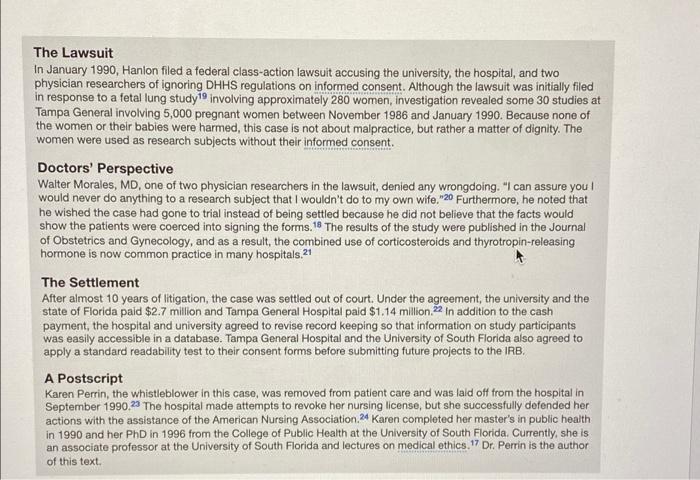In 1987, Karen Perrin reported to the high-risk perinatal outpatient clinic at Tampa General Hospital, which was affiliated with the University of South Florida in Tampa. She was looking forward to a busy day and the change of pace. Karen had worked at Tampa General since January 1986. Her normal assignment was labor and delivery, but as a part-time nurse, it was not unusual for her to fill in elsewhere. For the next two weeks, Karen worked at the outpatient high-risk pregnancy clinic while Sue, the clinic's head nurse, took time off for her wedding. In total, Karen was assigned to work in the clinic for a total of four weeks. She worked in the clinic for two weeks, returned to her regular position for two weeks, and then was again temporarily assigned to the clinic for two additional weeks because Sue's daughter became ill. Among other clinic tasks, Karen cared for high-risk pregnant women who came to the clinic for amniocentesis. Amniocentesis is a procedure in which a needle is inserted through a woman's abdomen to extract amniotic fluid for testing. 16 Karen entered each patient's name, hospital number, and Medicaid or Insurance number into the "amnio" record log at the desk. She took the patient's weight and blood pressure, measured her belly, and checked her urine. She set up the tray of amniocentesis needles and test tubes and labels for the tubes. She explained the procedure to the patients, offered reassurance, and asked if they had any questions. 17 During her clinic assignment, Karen noticed something unusual. The pregnant women did not ask questions about the procedure. "I kept seeing all these women having amnios. Over and over and over. I'd see them one week, I'd say, "Why are you back again?' I'm looking in their chart and I'm seeing that this is amnio #5, amnio #6. 16 When she talked with the pregnant women, it was clear that they did not understand why they were having so many amniocenteses. Their response was always the same: "The doctor told me, if I don't do them, my baby will die. 18 An Inquiry In late 1987, Karen consulted her supervisor. A meeting was scheduled with the vice president of nursing and the director of the perinatal unit. They told her that the pregnant women were part of a medical study that had been approved by the university and hospital IRBs. Therefore, they considered the matter closed. Her supervisor told her to drop the issue and not pursue additional investigation into the matter. Karen did not stop because she suspected that the women were unaware they were participating in a medical study. She continued to press for further investigation. In February 1988, a final meeting was held and the vice president of nursing made it clear that she had not taken any action and that she did not intend to investigate the matter further. The Next Step Karen shared her concerns with a friend who was a civil rights attorney, Stephen Hanlon. At the advice of Hanlon and the American Nursing Association, Karen was instructed to gather the evidence. She went to the high-risk clinic, took the amnio record log, made a copy, and returned the log to the clinic drawer. She returned a few days later to copy the last few pages, only to discover that "someone had taken a razor blade and cut all the pages out of the book. The pages were gone, and they were never found again. This was our only evidence."17 She provided the copied amnio record log to Hanlon. She also found the contact information for 10 women in the log who had multiple amniocenteses. She contacted them by mail and stated that their rights might have been violated and invited them to contact her. Only one woman, Flora Diaz, age 16, responded. The Lawsuit In January 1990, Hanlon filed a federal class-action lawsuit accusing the university, the hospital, and two physician researchers of ignoring DHHS regulations on informed consent. Although the lawsuit was initially filed in response to a fetal lung study involving approximately 280 women, investigation revealed some 30 studies at Tampa General involving 5,000 pregnant women between November 1986 and January 1990. Because none of the women or their babies were harmed, this case is not about malpractice, but rather a matter of dignity. The women were used as research subjects without their informed consent. Doctors' Perspective Walter Morales, MD, one of two physician researchers in the lawsuit, denied any wrongdoing. "I can assure you ! would never do anything to a research subject that I wouldn't do to my own wife. "20 Furthermore, he noted that he wished the case had gone to trial instead of being settled because he did not believe that the facts would show the patients were coerced into signing the forms.18 The results of the study were published in the Journal of Obstetrics and Gynecology, and as a result, the combined use of corticosteroids and thyrotropin-releasing hormone is now common practice in many hospitals. 21 The Settlement After almost 10 years of litigation, the case was settled out of court. Under the agreement, the university and the state of Florida paid $2.7 million and Tampa General Hospital paid $1.14 million 22 In addition to the cash payment, the hospital and university agreed to revise record keeping so that information on study participants was easily accessible in a database. Tampa General Hospital and the University of South Florida also agreed to apply a standard readability test to their consent forms before submitting future projects to the IRB. A Postscript Karen Perrin, the whistleblower in this case, was removed from patient care and was laid off from the hospital in September 1990.29 The hospital made attempts to revoke her nursing license, but she successfully defended her actions with the assistance of the American Nursing Association, 24 Karen completed her master's in public health in 1990 and her PhD in 1996 from the College of Public Health at the University of South Florida. Currently, she is an associate professor at the University of South Florida and lectures on medical ethics. 17 Dr. Perrin is the author of this text 1. Which ethical principles were being broken by the research team at Tampa General Hospital? (2 points) 2. In the case study, Dr. Morales felt that he had done no wrong and that he never did anything harmful to a research subject. Why do you think he feels his actions were justified? (2 points) What are some circumstances where you feel that NOT notifying the research subject about their participation in a study would be justified? (2 points) 3. Some of the pregnant women in this case study were subjected to 5 or 6 amniocentesis. Why do you think that they never questioned the number of procedures that they were 1 receiving? (2 points) Why did no other nurses or hospital personnel blow the whistle on these unethical practices? (2 points) What prevents whistle-blowing? (1 point)









